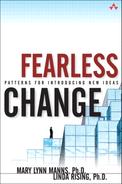Test the Waters
David Baum in his book Lightning in a Bottle notes, “The change process for most people is to slowly dip their toes into the water and ease into the shallow end, splashing a little water around and complaining about how cold it is.”[*]
When a new opportunity presents itself, see if there is any interest by using some of the patterns in this language and then evaluating the result.
![]()
You are excited about a new idea and you would like to be an Evangelist(144) for it in your organization.
When you learn about something new, you wonder if the organization is ready for it.
It isn’t always obvious where to start introducing a new idea into an organization. You don’t want to put much effort into introducing it if there really isn’t any interest. There’s a natural tendency for an enthusiastic change agent to try to make an impact much too quickly. Yet, you need to get your bearings. A “listen and learn” approach shows that you are willing to consider the opinions of others as you explain your new ideas.
You can’t fix everything at once, so the trick is to find the minimum number of leverage points to create a dramatic impact. Once you find the hot buttons, you can get things going.
Therefore:
Choose a pattern or two from this collection, use them, and then evaluate the result.
Begin with a few things that don’t take much effort, such as:
- Use Personal Touch(198) during a coffee break to informally talk with one of your colleagues, who might be an Innovator(170) or become a Guru on Your Side(158).
- Just Do It(177) and then give a simple demo or a Hometown Story(164) to a few colleagues.
- Schedule a Brown Bag(113) to present the idea to the rest of your team.
- Piggyback(201) on a regularly scheduled event.
- Plant the Seeds(204) around your organization.
These initial steps can help you decide what to do next. Evaluate what went well and what didn’t. Use Time for Reflection(240) to determine if it is The Right Time(207) for the new idea in your organization. If you encounter resistance, you may need to modify how you are presenting the proposed change. If you see some spark of interest, try some other patterns that will take more effort, such as Big Jolt(107) or Study Group(228).
Don’t just use this pattern when you begin to introduce an innovation. Test the Waters along the way and every time you see a new opportunity.
= = = = = = = = =
This pattern builds a foundation upon which you can use other patterns. It is the first step in trying to become an Evangelist(144). It helps you to see if you should proceed and, if so, what you should do next.
But be prepared for possible disappointment. Sometimes an idea is too new or radical for ready acceptance by an organization, or it may run counter to other constraints, such as a preference for a vendor or product. Rather than pushing harder, it may be better to wait a bit until the organization can support the change. Save your energy for when you can get payback. The time you took to investigate and learn about the innovation will still work to your own personal advantage.
When Peace Corps volunteers arrive at their destination, they are brimming with energy and enthusiasm. But volunteers must fight the impulse to hit the ground running because a slow crawl works much better. Volunteers are advised, “During your first two weeks on site, don’t start calling meetings and making pronouncements. Spend time observing your village and listening to people talk about their lives. Slowly, you will identify some natural places where you can intervene and share some ideas. To earn trust, you must demonstrate a presence and show that you’re genuinely interested in learning as well as teaching.”[*]
In their best selling book, Built to Last, Jim Collins and Jerry Porras noted that “3M did not select innovations based strictly on market size. With mottos like ‘Make a little, sell a little’ and ‘Take small steps,’ 3M understood that big things often evolve from little things; but since you can’t tell ahead of time which little things will turn into big things, you have to try lots of little things, keep the ones that work, and discard the ones that don’t.”[**]
